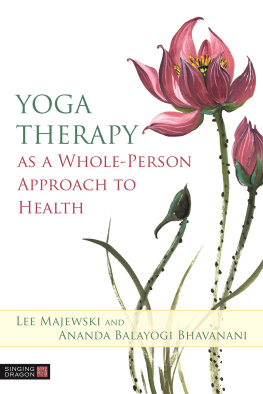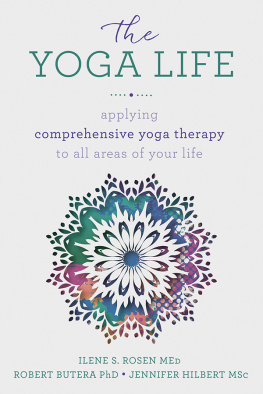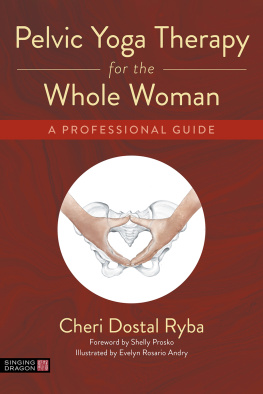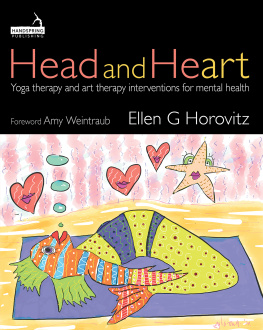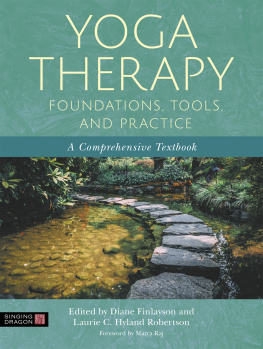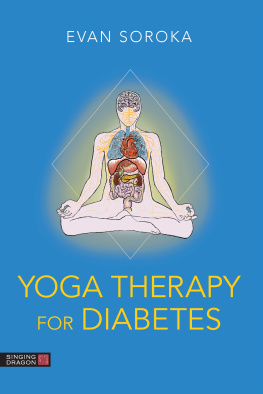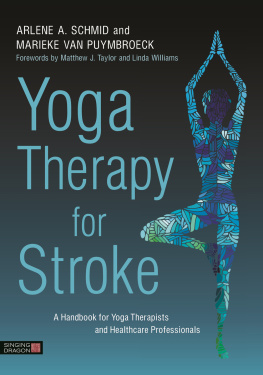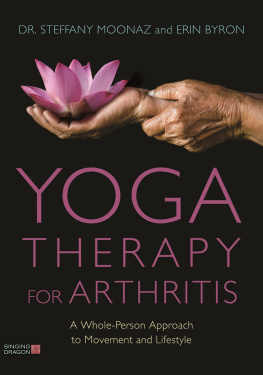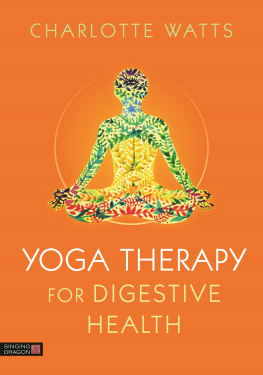Lee Majewski - Yoga Therapy as a Whole-Person Approach to Health
Here you can read online Lee Majewski - Yoga Therapy as a Whole-Person Approach to Health full text of the book (entire story) in english for free. Download pdf and epub, get meaning, cover and reviews about this ebook. year: 2020, publisher: Jessica Kingsley Publishers, genre: Religion. Description of the work, (preface) as well as reviews are available. Best literature library LitArk.com created for fans of good reading and offers a wide selection of genres:
Romance novel
Science fiction
Adventure
Detective
Science
History
Home and family
Prose
Art
Politics
Computer
Non-fiction
Religion
Business
Children
Humor
Choose a favorite category and find really read worthwhile books. Enjoy immersion in the world of imagination, feel the emotions of the characters or learn something new for yourself, make an fascinating discovery.
- Book:Yoga Therapy as a Whole-Person Approach to Health
- Author:
- Publisher:Jessica Kingsley Publishers
- Genre:
- Year:2020
- Rating:5 / 5
- Favourites:Add to favourites
- Your mark:
- 100
- 1
- 2
- 3
- 4
- 5
Yoga Therapy as a Whole-Person Approach to Health: summary, description and annotation
We offer to read an annotation, description, summary or preface (depends on what the author of the book "Yoga Therapy as a Whole-Person Approach to Health" wrote himself). If you haven't found the necessary information about the book — write in the comments, we will try to find it.
Yoga Therapy as a Whole-Person Approach to Health — read online for free the complete book (whole text) full work
Below is the text of the book, divided by pages. System saving the place of the last page read, allows you to conveniently read the book "Yoga Therapy as a Whole-Person Approach to Health" online for free, without having to search again every time where you left off. Put a bookmark, and you can go to the page where you finished reading at any time.
Font size:
Interval:
Bookmark:

YOGA
THERAPY
AS A W HOLE -P ERSON A PPROACH TO H EALTH
L EE M AJEWSKI AND
A NANDA B ALAYOGI B HAVANANI
F OREWORD BY S TEPHEN P ARKER

This work has been written by two authors with a profound respect for both scientific validation and for the depth and complexity of the yoga tradition, beyond what science can measure. Lee Majewski MA C-IAYT is a long-time yoga teacher and certified yoga therapist and a visiting faculty member of Kaivalyadhma Yoga Institute, Lonavla, Maharashtra, India. Her personal experience of living with her cancer treatment provided the impetus for the design of the retreats described in the book. She is a frequent presenter in international conferences and has trained many therapists and yoga teachers in the conduct of the retreats. Ananda Bhavanani MD is a physician and certified yoga therapist who is also the successor of a venerable yoga lineage through his father, Swm Gtnanda Giri and their guru Kanaknanda Bhrigu, more familiarly known by his pre-monastic name as Ram Gopal Majumdar, the sleepless saint of Paramahansa Yognandas Autobiography of a Yogi . Dr. Bhavanani directs a yoga therapy training program, the Center for Yoga Therapy Education and Research of the r Blji Vidyptha, a deemed university and medical school in Pondicherry in South India.
This book serves a number of important purposes. The first part of the book is an excellent introduction to the philosophy of yoga therapy from a yogic perspective. As such it is much-recommended reading for those with a general interest in yoga therapy. It serves as a corrective to the drift of this budding profession towards becoming a sub-discipline of medicine and physical therapy, where yogic practices are applied prescriptively, solely according to a medical diagnosis. This is what Bhavanani calls yogopathy. Majewski and Bhavanani give a detailed account of what a whole person, yogic process of diagnosis would look like. It is not enough to simply criticize, and these authors have gone the extra mile to fill out how a yogic perspective might approach the work of healing. It is significant to remember that in English, as well as many other Indo-European languages, the word heal comes from the same root as whole and holy.
In addition to holding a respect for the depth of the practices of yoga, the book also maintains respect for the ancient yur-vedic medical system, authored, in part, by the same Patajali who codified the yoga science. (This is the opinion of the oral tradition of yoga through my preceptors, Swm Rma of the Himlayas and Swm Veda Bhrat, not necessarily of Indological academics.) The practices of yoga have always been an important part of what an yur-vedic physician ( vaidya ) would offer people in addition to dietary prescriptions, herbal treatments and more. By looking at the whole person in context, the system provides not only holistic treatment, but, even more importantly, given the prevalence of chronic (habit-based) lifestyle illnesses today, a preventative focus that promotes long-term changes and improvement in the quality of life, particularly the cultivation of a resilient and joyful mind and heart.
One of the critical issues the authors tackle convincingly in conceiving holistic yoga therapy is the frequent disinclination of scientifically oriented yoga therapy to embrace the importance of spirituality to healing. This occurs despite a considerable body of empirical evidence which demonstrates that spirituality strongly potentiates healing. Here spirituality is understood as practices which facilitate a relationship with the highest levels of consciousness, rather than confusing it with religion, which comprises specific, culture-bound prescriptions for the nature of that relationship. This is particularly true in addressing the isolation, exhaustion, and hopelessness that patients are often left with at the conclusion of their prescribed medical treatment. In the case of Majewskis experience of her own cancer and that of retreat participants, she notes how often this isolation and hopelessness pushes patients towards ending their lives. The deeper one goes into the layers of embodiment presented by yoga through the system of koshas , the more extensive the spiritual healing effect can become. A similar argument was made by quantum physicist Amit Goswami PhD in his book, The Quantum Doctor , as he constructed a quantum model of healing that demonstrates how allopathy, homeopathy and yur-veda can all work in collaboration if one understands the levels at which those healing systems work.
The second part of the book describes four clusters of non-communicable illnesses which account for approximately 80 percent of deaths: chronic respiratory illnesses, cardiovascular diseases, diabetes mellitus, and cancer. This section provides evidence-based descriptions of what a holistic yoga therapy approach to these problems can offer. The most beautiful part of this section of the book is the personal account of Majewskis experience with her cancer treatment, which was effective in a medical sense, but which left her without a map for many of the exhausting, painful, and debilitating sequelae. This is important material for medical professionals to read because it details the patient experience of being left resourceless at the conclusion of the medical treatments, just when a person is at their most exhausted, depleted, and dis-spirited.
This inattention to the psychological side of illness, to the dis-ease which is the relationship every patient has to their illness, is a problem that appears wherever clinicians fear starts running the show from the sidelines. It is very tempting in these circumstances to simply throw science and technology at the illness. This writer saw many similar examples of this in the early days of the HIV/AIDS epidemic. It may seem surprising to some that fear of cancer still exerts such an influence on treatment, but the fear of disembodiment, as Patajali tells us, is ubiquitous in humans and the ultimate source of all our fears. The yoga system, which is about healing relationship at every level of practice from the first item in the list of limbs of yoga, non-violence, provides the ultimate permanent freedom from fear (for both patients and clinicians).
In the third section of the book, the authors provide a small-group residential retreat format that addresses each level of embodiment in the yoga system, which has never separated mind and body as medical systems have done in Western allopathic medicine. The three weeks of these retreats are packed with practices that refocus peoples awareness of their mind-body and bring the whole person back together, as it were. Then there is a regular follow-up to help people to maintain the changes they have made. The measurement of these follow-up sessions to date validates the long-term effectiveness of the retreats.
The retreat format includes detailed descriptions of the practices used, so that the design is reproducible. These are taken from versions of hatha yoga and pranayama practice which come largely from the teaching of Kaivalyadhma, one of the oldest modern yoga institutions in India and the first to conduct scientific research starting in the 1920s, from Richard Millers version of practices for yoga nidr (iRest) and from the Sikh tradition of Kundalini yoga. This creates an invitation to test these practices both in scientific experimentation and in personal experience, which is always the true test of any yogic practice. It also provides the opportunity to test practices from other traditions in which a given yoga therapist may be trained. My own guru, Swm Rma, always encouraged us to test everything he gave us. Dont just believe what I saybe a scientist!, he would say.
Font size:
Interval:
Bookmark:
Similar books «Yoga Therapy as a Whole-Person Approach to Health»
Look at similar books to Yoga Therapy as a Whole-Person Approach to Health. We have selected literature similar in name and meaning in the hope of providing readers with more options to find new, interesting, not yet read works.
Discussion, reviews of the book Yoga Therapy as a Whole-Person Approach to Health and just readers' own opinions. Leave your comments, write what you think about the work, its meaning or the main characters. Specify what exactly you liked and what you didn't like, and why you think so.

